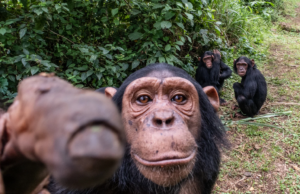GAP BRAZIL: Chimpanzees Feel Safe in Latin America’s Largest Primate Sanctuary
 Caption: EL MAYOR SANTUARIO DE CHIMPANCÉS DE A.LATINA, UN REFUGIO CONTRA LOS TRAUMAS
Caption: EL MAYOR SANTUARIO DE CHIMPANCÉS DE A.LATINA, UN REFUGIO CONTRA LOS TRAUMAS
SAO PAULO – Far away from their nerve-wracking days as a spectacle for the public, some 50 chimpanzees live together in Sorocaba, a small Brazilian town repurposed as a refuge for big primates recovering from a traumatic life in zoos and circuses.
High up a cement tower, a 20-year-old chimpanzee named Dolores jumps compulsively, claps her hands and screams incessantly, even as her fellow chimps regard her with a certain indifference. These are the effects of her years in the circus, which left her “completely crazy,” according to Pedro Ynterian, owner of this refuge in Sao Paulo state’s interior region.
The primate settlement was founded 20 years ago and became truly professional in the year 2000, when Ynterian decided to team up with the Great Ape Project (GAP), an international movement that fights for the life, liberty and absolutely no torture of chimpanzees, gorillas, orangutans and bonobos.
Just as in zoos and circuses, the animals in this “sacred temple” live in captivity but under conditions, Ynterian says, that are very different – they suffer no stress from the public, the installations give them far more space and food is unlimited.
Chimpanzees are the main feature of this sanctuary spanning 500,000 square meters (5.4 million square feet), but there are also other simian species, birds, lions and bears “rescued” by regional authorities from circuses and zoos, as well as from animal trafficking rings.
“I don’t usually accept any more animals. In the case of monkeys and birds, I’d rather set them free. With chimpanzees it’s different because they have nowhere to go. They’re from Africa and the Africans won’t take them back,” said Ynterian, 77, a microbiologist and owner of a pregnancy testing laboratory.
His Brazilian refuge will likely be the new home of Cecilia, a chimpanzee from a zoo in Mendoza, Argentina, which was closed to the public last year after a series of deaths.
Following a legal uproar, a provincial court issued a writ of habeas corpus and authorized the chimpanzee’s transfer, which could occur in the coming months.
“For Cecilia, this will be totally different. If she’s healthy enough to survive the process, she’ll have a very happy life,” the refuge owner said.
Sorocaba’s chimpanzees live in a kind of cement-walled fortress divided into different compartments, each shared by members of the same group.
There is grass inside but no trees, since, according to Ynterian, the branches were used by the primates as springboards to leap over the walls.
Primates in the refuge have all kinds of food available, but just like people – with whom they have 99.4 percent of their DNA in common – they have their favorites: chicken pies, soft drinks, and yogurt with carrots, oranges and honey.
Ynterian arrives at the sanctuary at 3:00 am every day to prepare the chimpanzees’ meals – because they’re all part of the family, he feels, especially Guga, 16, a tame, playful male that grew up in the refuge.
Other chimps are more nervous, like Alex and Bob, whose teeth were extracted in the circus before regional laws banned the use of animals as entertainment.
Original article: http://www.laht.com/article.asp?ArticleId=2430721&CategoryId=13936
Check amazing photos of the chimpanzees at the sanctuary at European Pressphoto Agency: http://www.epa.eu/human-interest-photos/animals-photos/the-largest-latin-american-chimpanzee-sanctuary-photos-53309579

 Español
Español
 Português
Português








